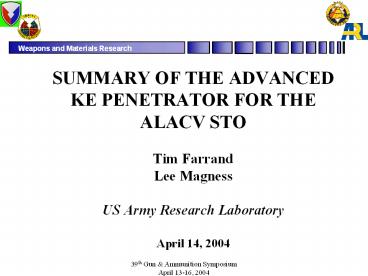39th Gun - PowerPoint PPT Presentation
1 / 18
Title:
39th Gun
Description:
Achieve a 30% increase in behind armor effects (BAE) over a baseline APFSDS penetrator. ... ENLE greater Behind Armor Effects. 39th Gun & Ammunition Symposium ... – PowerPoint PPT presentation
Number of Views:83
Avg rating:3.0/5.0
Title: 39th Gun
1
SUMMARY OF THE ADVANCED KE PENETRATOR FOR THE
ALACV STO Tim FarrandLee MagnessUS Army
Research LaboratoryApril 14, 2004
2
Supporting Cast
Tim Farrand Lee Magness WMRD Terminal
Ballistics Robert Shnidman, John Abell SLAD -
wit pack analysis/reduction Jodi Roberston, Rob
Gangler, SLAD LoF systematic analysis Jim
Strobel (ret), experimental LoF Aivars
Ozolins (Oz) Experimental facility WMRD
target/wit pack set-up and execution Shops WMR
D manufacture targets, sabots, etc. SLAD
witness packs assemble reduction
3
Overview of ALACV KE
- Initial Paper Study
- Quantify STO requirement
- Establish Experimental Methodology
- Iterative Progression of Penetrator Design
- Terminal Ballistic evaluations
- BAD Analysis
- Final Design
- Monolithic
- ENLE
4
STO Objectives - Exit CriteriaAdvanced KE
- Develop and demonstrate advanced KE penetrators
using tungsten or other alternative materials - Exit Criteria
- Achieve a 30 increase in behind armor effects
(BAE) over a baseline APFSDS penetrator. - Relate a 30 increase in the combined (BAE) to an
increase in Probability of Kill (Pk) of 10 over
the baseline.
5
Quantified 30 BAE Increase
MF-KILL VS CALIBER
UPPER LIMIT
A SLAD Parametric Study of lightly armored vehicle
Goal 30 increase in BAE
Loss of Function
BASELINE
Penetrator Size
6
Establish Experimental Methodology
Use one range target for down select of
Penetrator Designs - modified vehicle
description
EXAMPLE
ONE RANGE TGT
MODIFY TGT (Swap Ammo Crew)
- Final Target Model
- One Range Target (impact location)
- Modify Interior of Vehicle
- Produced Similar Results to a Cardioid Average
- Good Representative Target
7
Data Analysis
RADIOGRAPHS
Examine Penetrator Performance Qualify
penetrator failure mechanisms Estimate Defeat
Range Evaluate Behind Armor Effects Penetrator
and Target
WITNESS PANELS
8
Design Iterations
Design Iterations Shots 1
scaled design 11 2 alternate designs
ENLE 35 2a supplement w/ mission
evaluations (Magness) 30 3 ENLE
designs 26 4 Material Geometry
mods 35 5 ENLE mods 10 6 ENLE mods
(fins dia) 15 7 Final design w/
baseline 71
9
Behind Armor Debris (Phase 1 2)
Medium Overmatches ENLE greater Behind Armor
Effects
10
Loss of Function for Range Target(Phase 1 2)
SURVIVABILITY/LETHALITY ANALYSIS DIRECTORATE
Increase Behind Armor Effects At Closer Ranges
UPPER LIMIT
A
B
D
G
E
C
F
H
BASELINE
Loose Defeat Range Slightly
11
Behind Armor Debris (Phase 3)
Medium Overmatches ENLE greater Behind Armor
Effects
12
Modeling / AnalysisFinal Design
- Modify Perforation models for specific Mono
ENLE designs - Develop BAD models for MONO ENLE
- Input Perforation and BAD models into Lethality
Target Model - Run Lethality Target Model for
- All angles of attack
- Average for frontal 60o arc Cardioid average
13
Behind Armor Debris (Final Design)
Red ENLE Black MONO Obliquity Targets Simple
Complex
Shapes Solid Hollow
14
Implementation of IncreasedPenetrator Fragments
SURVIVABILITY/LETHALITY ANALYSIS DIRECTORATE
If Residual Velocity is between 250 800 m/s
then Fragments are Effective
15
System Engagement Weighting Averages
SURVIVABILITY/LETHALITY ANALYSIS DIRECTORATE
12.5
8.4
17.25
2.75
4.2
10.05
29.25
.75
1.2
13.65
0.0
0.0
13.65
1.2
29.25
.75
10.05
4.2
17.25
2.75
8.4
12.5
FRONTAL
CARDIOID
16
Final Results(Cardioid Average)
SURVIVABILITY/LETHALITY ANALYSIS DIRECTORATE
Increase in Behind Armor Effects Counterbalanced
by Decrease in Defeat Range
ENLE
Performance is best at Close Range
17
Final Results(Frontal Attack)
SURVIVABILITY/LETHALITY ANALYSIS DIRECTORATE
Effects Exaggerated For Tougher Target Areas
ENLE
18
Conclusions
- Completed Experimental Evaluation
- gt205 shots fired perforation BAD
- gt175 shots BAD examine witness packs
- Modified Lethality Model is a very useful tool
- Range Target
- Modified Description
- ALACV Advanced KE Improvement
- Highly Dependent on Overmatch
- Target
- Range































